Blue Light Blocking Glasses Market Research, 2034
The global blue light blocking glasses market size was valued at $2.9 billion in 2024, and is projected to reach $5.8 billion by 2034, growing at a CAGR of 7.3% from 2025 to 2034. Blue light blocking glasses reduce exposure to high-energy visible (HEV) blue light emitted from digital screens, artificial lighting, and sunlight. The lenses feature special coatings or built-in filters that block and absorb blue light. These glasses help reduce eye strain, alleviate symptoms such as headaches and dry eyes, and minimize sleep disruption, which help promote better visual comfort and support overall eye health during extended screen time.
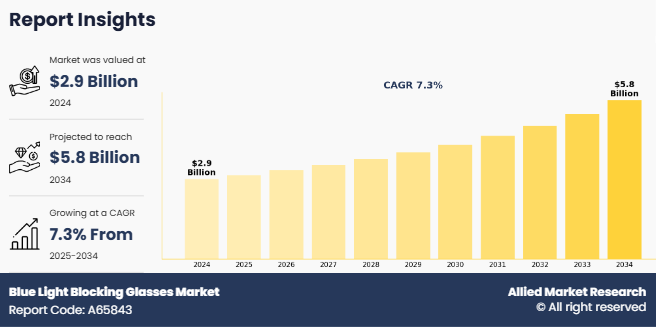
Market Dynamics
Surge in remote work and online education has led to extended screen exposure, driving strong demand for blue light blocking glasses. Continuous use of computers for meetings, assignments, and communication has raised concerns about digital eye strain, poor sleep quality, and vision-related discomfort. Blue light blocking glasses are increasingly used by professionals working remotely and students as a practical measure to reduce eye fatigue. The shift to digital platforms in both work and education has made prolonged screen use unavoidable, which in turn has encouraged consumers to invest in blue light blocking glasses that support eye comfort during extended screen engagement.
According to the 2024 report by The American Academy of Child and Adolescent Psychiatry, children in the U.S. between the ages of 8 and 12 spend an average of 4 to 6 hours per day on screens, and teenagers spend up to 9 hours. Rise in screen time among younger age groups has increased parental attention toward protecting children's eye health. Blue light blocking glasses designed specifically for children, teenagers, college students, and remote workers are gaining traction, owing to growth in concerns regarding long-term vision impact. As a result, brands are expanding product lines to meet the distinct needs of each group, including size, fit, and style preferences, thus driving the blue light blocking glasses market growth.
However, competition from alternative solutions such as screen filters and software applications has restrained growth of blue light blocking glasses industry. Built-in display settings, downloadable applications, and external screen protectors offer blue light reduction with minimal effort or cost. Many electronic devices feature display modes that reduce blue wavelength intensity during evening hours by shifting screen color temperatures. Consumers often prefer integrated or software-based options, owing to ease of use and no requirement for additional accessories. Adoption of digital adjustments has slowed interest in eyewear-based solutions such as blue light blocking glasses, particularly among users already relying on existing screen-based tools for visual comfort.
In addition, software filters and screen protectors reduce the need for continuous eyewear use, addressing concerns related to comfort, convenience, and personal style. For individuals without vision correction needs, software-based methods serve as practical alternatives. Blue light filtering glasses face additional challenges owing to perceived redundancy when comparable results can be achieved through device settings or external screen layers. Multiple available options have divided consumer attention and created barriers to widespread usage of eyewear. Thus, increased reliance on built-in or app-based blue light reduction tools is anticipated to hinder the growth of the blue light blocking glasses market.
Furthermore, integration of blue light filtering in prescription glasses is creating targeted opportunities in the expansion of blue light blocking glasses market share. Individuals with refractive errors such as myopia, hyperopia, and astigmatism seek lenses that deliver both corrective vision support and protection from blue light exposure caused by digital screens. Blue light filtration is being embedded as a coating or integrated layer during prescription lens manufacturing, allowing users to rely on a single pair of glasses. The combined utility addresses rise in demand from users in work-from-home settings, educational institutions, and digitally focused professions. Brands including Essilor with Eyezen and Crizal Prevencia, Zeiss with BlueGuard, and Hoya Vision with BlueControl have introduced such prescription solutions, reinforcing availability through optical professionals and retail outlets.
Prescription glasses with integrated blue light protection have broadened market access to professionals, students, and older adults who require daily vision support. The added function enhances everyday usability and drives consistent wear, improving perceived value. Retailers such as Warby Parker, EyeBuyDirect, and Felix Gray offer tailored lens options with blue light filtration, spanning various styles and pricing range. Awareness of eye fatigue and sleep-related challenges linked to extended screen time continues to drive demand for prescription eyewear equipped with blue light filtering.
Segmental Overview
The blue light blocking glasses market is segmented into lens type, end user, distribution channel, and region. By lens type, the market is segmented into clear lenses, yellow-tinted lenses, and amber-tinted lenses. By end user, the market is categorized into computer users, students, gamers and others. By distribution channel, the market is fragmented into optical stores, supermarkets/hypermarkets, specialty stores, and online sales channel. By region, the market is analyzed across North America (U.S., Canada, and Mexico), Europe (Germany, UK, France, Italy, Spain, and rest of Europe), Asia-Pacific (China, Japan, India, South Korea, Australia, Singapore, and rest of Asia Pacific), and LAMEA (Brazil, Argentina, South Africa, Saudi Arabia, UAE, and rest of LAMEA).
By Lens Type
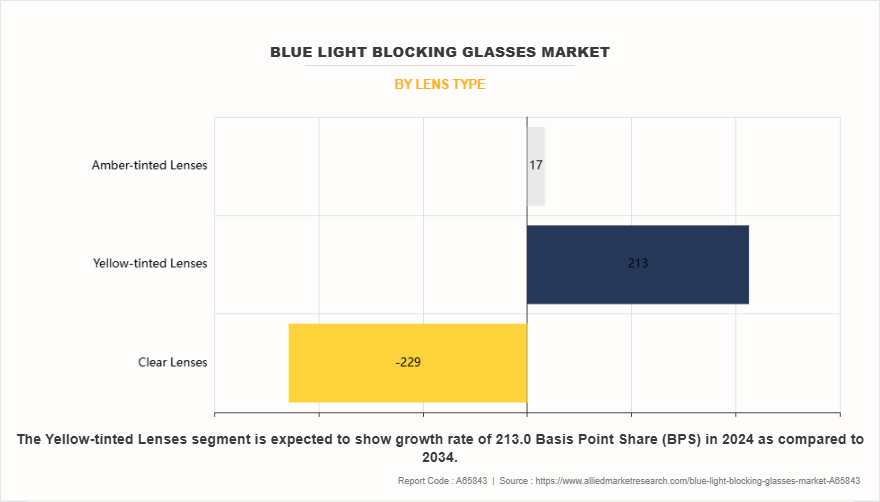
By lens type, the clear lenses segment dominated the global blue light blocking glasses market in 2024 and is anticipated to maintain its dominance during the forecast period. Clear lenses are becoming more widely used in blue light blocking glasses, especially among professionals in office and remote work environments. The transparent appearance of clear lenses allows for daily wear without affecting screen colors or drawing attention in formal settings. Employees in finance, legal, IT, and corporate roles are increasingly selecting clear lenses to maintain a polished look along with managing screen-related eye strain during long work hours.
Also, prescription eyewear users are shifting toward clear lenses that offer built-in blue light filtration. Optical retailers and vision care brands have expanded product lines to include clear lenses that combine refractive correction with screen protection, as it eliminates the need for multiple pairs. The combined function of clear lenses addresses the needs of individuals in academic and professional roles who rely heavily on digital devices and require both clarity and comfort throughout the day, thus driving the growth of this segment.
By End User
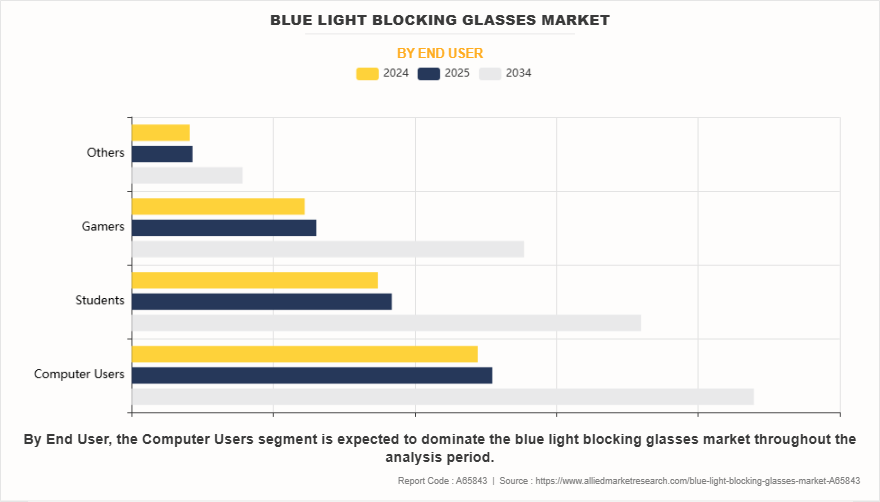
By end user, the computer users segment dominated the global blue light blocking glasses market in 2024 and is anticipated to maintain its dominance during the forecast period. Office professionals, remote workers, and digital freelancers often spend 8 to 10 hours daily on tasks such as data entry, coding, and video conferencing, which increases concerns regarding digital eye strain from blue light exposure. As a result, demand for eyewear that filters blue light has increased, providing comfort and visual clarity. Rise in focus on occupational wellness and productivity has created opportunities for eyewear manufacturers to offer specialized products, such as clear lenses with minimal color distortion, to meet the needs of computer users. As screen reliance continues to grow, computer users have become a key segment in the blue light blocking glasses market, further contributing to the market expansion.
By Distribution Channel
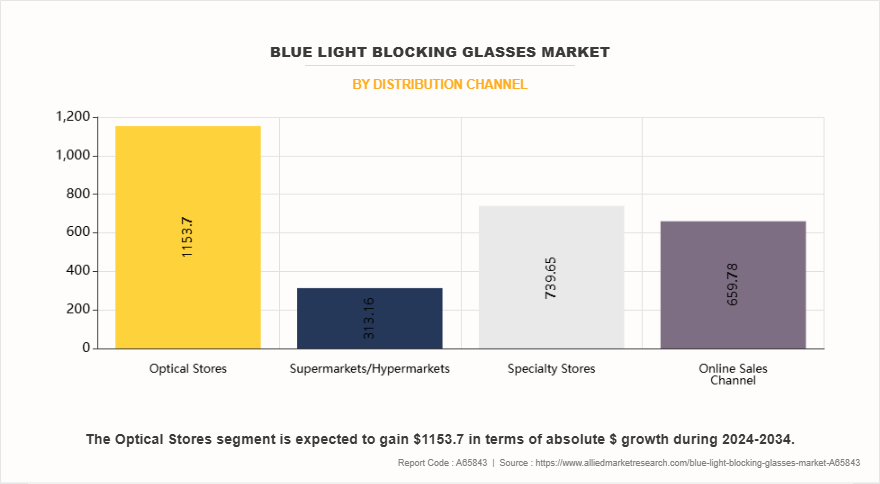
By distribution channel, the optical stores segment dominated the global blue light blocking glasses market in 2024 and is anticipated to maintain its dominance during the forecast period. Optical stores have seen increased sales of blue light blocking glasses owing to their ability to offer personalized services and expert advice on eye health. Customers prefer optical stores for the tailored solutions they provide, including prescription options for blue light blocking glasses. In addition, optical stores can conduct eye exams and recommend eyewear suited for specific needs, boosting customer trust. The in-store experience, which allows customers to try on glasses and receive professional guidance, enhances consumer confidence in purchasing blue light blocking glasses. Furthermore, optical stores offer a range of high-quality options and convenience, making them a preferred choice for customers seeking specialized eyewear.
By Region
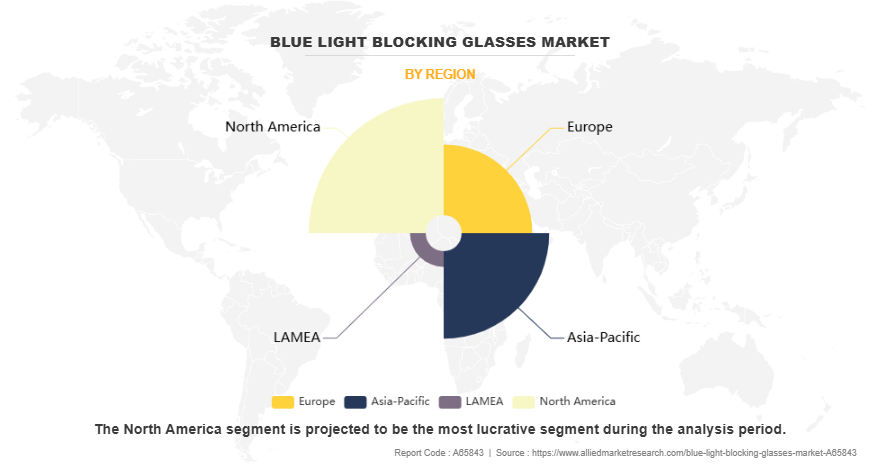
By region, North America is anticipated to dominate the global blue light blocking glasses market with the largest share during the forecast period. The demand for blue light blocking glasses has surged in North America owing to rise in concerns related to digital eye strain, as more people spend extended hours on screens for work, entertainment, and education. Optical stores and online platforms have responded by offering a variety of glasses designed to reduce eye strain and improve comfort. Established brands such as Gunnar Optiks, Warby Parker, and Felix Gray, have played a significant role in expanding market reach by offering stylish, functional eyewear solutions with blue light filtering technology. Their wide availability, along with rise in focus on digital wellness, has contributed to sustained growth in the blue light blocking glasses market in the region.
Competition Analysis
The key players operating in the global blue light blocking glasses market report include Baxter Blue, Blueberry, Cyxus, Felix Gray, Gunnar Optiks, Jins Holdings Inc., Pixel Eyewear, Swanwick, Warby Parker, and Zenni Optical, Inc. Several well-known and upcoming brands are vying for market dominance in the expanding blue light blocking glasses market in the region. Smaller, niche firms are more well known for catering to consumer demands and preferences in the global market. Large conglomerates, however, control most of the market and often buy innovative start-ups to broaden their product lines.
Key Benefits For Stakeholders
- This report provides a quantitative analysis of the market segments, current trends, estimations, and dynamics of the blue light blocking glasses market analysis from 2024 to 2034 to identify the prevailing blue light blocking glasses market opportunities.
- The market research is offered along with information related to key drivers, restraints, and opportunities.
- Porter's five forces analysis highlights the potency of buyers and suppliers to enable stakeholders make profit-oriented business decisions and strengthen their supplier-buyer network.
- In-depth analysis of the blue light blocking glasses market segmentation assists to determine the prevailing market opportunities.
- Major countries in each region are mapped according to their revenue contribution to the global market.
- Market player positioning facilitates benchmarking and provides a clear understanding of the present position of the market players.
- The report includes the analysis of the regional as well as global blue light blocking glasses market trends, key players, market segments, application areas, and market growth strategies.
Blue Light Blocking Glasses Market Report Highlights
| Aspects | Details |
| Market Size By 2034 | USD 5.8 billion |
| Growth Rate | CAGR of 7.3% |
| Forecast period | 2024 - 2034 |
| Report Pages | 495 |
| By Lens Type |
|
| By End User |
|
| By Distribution Channel |
|
| By Region |
|
| Key Market Players | Blueberry, Felix Gray?, Cyxus?, Gunnar Optiks?, Zenni Optical, Inc., Warby Parker?, Jins Holdings Inc., Pixel Eyewear?, Swanwick, Baxter Blue |
Analyst Review
This section consists of the opinion of the top CXO in the blue light blocking glasses market. CXOs stated that the blue light blocking glasses market is expected to experience significant growth in the next decade. Digital dependency, boosted by remote work, gaming, and increased screen time, is encouraging consumers to seek blue light blocking glasses that protects them from digital eye strain. As digital devices become integral to daily life, demand for blue light blocking glasses is expected to grow from niche markets to everyday essentials.
Health awareness is rising, with consumers increasingly recognizing the negative impact of blue light on eye health and sleep. Technological advancements are transforming the market, with innovations such as smart glasses that adjust to screen time. Sustainability is also a growing trend, with eco-friendly materials and transparent manufacturing practices becoming key considerations for consumers. Emerging markets in Asia-Pacific, Africa, and Latin America offer new growth opportunities as digital engagement rises, while the demand for affordable, accessible solutions remains strong. Despite challenges such as market fragmentation and price sensitivity in some regions, targeted marketing strategies and direct-to-consumer models will help drive growth in the blue light blocking glasses market.
The blue light blocking glasses market was valued at $2,907.1 million in 2024.
Upcoming trends include smart glasses integration, prescription blue light blocking lenses, stylish designs, and advanced customizable filtering technologies.
Clear lenses is the leading segment in blue light blocking glasses market.
By region, North America is anticipated to dominate the global blue light blocking glasses market with the largest share during the forecast period.
The key players operating in the global blue light blocking glasses industry include Baxter Blue, Blueberry, Cyxus, Felix Gray, Gunnar Optiks, Jins Holdings Inc., Pixel Eyewear, Swanwick, Warby Parker, and Zenni Optical, Inc.
Loading Table Of Content...
Loading Research Methodology...



